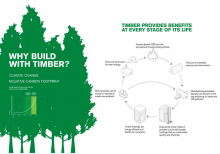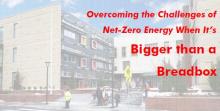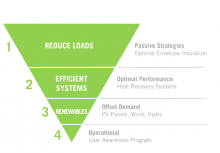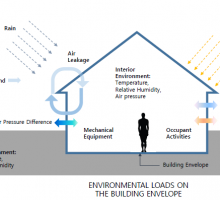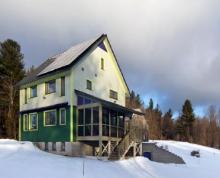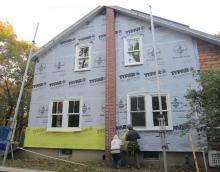Combating Climate Change with Timber Construction
With its smaller carbon footprint, timber construction should be considered alongside steel and concrete to build both low and mid-rise projects. This session will introduce innovations in timber technology, and through case studies demonstrate the wide range of benefits including environmental benefits. With buildings in the U. S. accounting for 38% of all carbon emissions and with population growth on the rise, we must reconsider how we construct our buildings. Climate change can be combatted in two ways –by reducing carbon emissions and by removing carbon from the atmosphere – and timber is unique in that it is the only building material that can do both. Recent innovations in timber technology is paving the way for timber once again to become integral to the fabric of cities, at this pivotal moment in time.
Passiv for the Masses
Climate change has made mainstream adoption of high-performance buildings a priority, and the Passivhaus standard provides a means to assess and drive the performance of these buildings. With 16 certified Passivhaus buildings between them, industry leaders Adam Cohen, Alan Gibson and Mathew Omalia will discuss their experiences designing and constructing a wide spectrum of building types, styles and scales that meet the Passivhaus standard. Adam Cohen will discuss techniques used to design, manufacture and construct Passivhaus buildings that cost the same or less than comparable code buildings. Alan Gibson will talk about simplifying construction systems and assemblies, and lessons learned about structure, moisture, air sealing, and air quality. Matt Omalia will explore how to integrate Passivhaus parameters into the design process to create a new canon of architectural design. The presenters will use case studies including: single and multi-family homes, schools, university residence halls, and community buildings.
The Challenges of Net Zero Energy When It's Bigger than a Breadbox
Municipalities and other owners of large buildings are increasingly setting their sites on net-zero. This session will feature a case study of the 190,000sf Martin Luther King, Jr. School, the first of the Cambridge public schools to target NZE. Presenters will discuss the process, content and tools used at design workshops and user group meetings to gather, analyze, ideate and integrate information into design solutions while also facilitating cultural and behavioral change among users. They will highlight the challenges and gritty details involved in shepherding both this project and others—including issues related to codes, day-lighting, systems selection, load management, maintenance, and product selection. Attendees will learn what worked, what didn’t, and why.
Aiming at Zero: The Struggle to Get There
Everyone is talking about getting to zero energy by 2030. It’s easy to say, but very hard to do. What is the process and how do we ratchet down our EUI on each project? How can goal setting and Client priorities influence energy use and building performance? Can we actually get to zero? This lively moderated panel discussion will include the Architect, Engineer, and Owner/ Client on Weygand Hall at Bridgewater State University (completed in 2013) and on Keene State College (currently under construction). We will address the planning, design, and results of both projects as well as the ZNEB pilot study completed simultaneously with Weygand Hall. We will show best practices and lessons learned from each experience. We will focus on the continuum of these projects over time, how each process and learning experience influenced the next, and how this iterative approach leads to better energy performance and keeps us on track for 2030.
Success through Quality Management: Building a Stronger Company
Quality experts estimate that 25-40% of dollars spent by typical businesses is waste. Companies focused on quality spend less, reduce waste, cut operating costs, and invest in processes that result in: greater profits; stronger financial position; improved competitive capabilities; operational stability; greater customer success/satisfaction, and setting trends for the industry. Simply put, no service-based industry has ever made less money by doing things right the first time. For owners, partners, operation managers, and supervisors.
A Prototype Visualization Tool for Hygrothermal Analysis
Recent developments in the field of building simulation and computing power are allowing architects to effectively move performance analysis of designs into the early stages of the design process. These developments aim to allow for the rapid iteration of design solutions that examine various performance criteria. This presentation describes a prototype tool that can serve as a platform to merge large amounts of building performance simulation data coupling various performance criteria. A case study using the prototype tool that uses WUFI engine to simulate moisture movement and analyze the related risk for mold growth and for building component failure using ASHRAE standards. The conclusions show that key insights can be quickly obtained using this tool, demonstrating its potential to increase our understanding of building performance. It also lays the groundwork for a more seamless integration of hygrothermal modeling into the whole building analysis process.
Mainstreaming Resilience: Making Resilient Design Standard Practice
While few argue about the importance of resilience in an age of climate change (with more intense storms, rising sea levels, more frequent drought, and worsening heat waves), there remains little focus on resilient design in building codes, zoning bylaws, and voluntary building rating systems, such as Passive House, Living Building Challenge, and LEED. In this interactive session, the presenters will lead a discussion about how to make resilient design more of a mainstream focus. They will report on inherent resilience aspects of Passive House, recent changes to the Living Building Challenge that address resilience, and new LEED pilot credits.
When You Come to a Fork, Take It. Residential Choices and Performance
Decisons, decisions. Residential design is always part education, part therapy, and part architecture. This panel will showcase the work of two designers and a builder who have climbed high on the residential decision-making tree. Architect Chris Briley will explore the challenges of two Passive House projects, in the same climate, with different clients, as he worked with each to come to different conclusions and different strategies for the same high performance target. Jesse Selman and Kent Hicks (architect and builder) will discuss the complex process of navigating the sometimes conflicting goals of high performance, thoughtful design, and the needs of a client with an existing building, a beautiful site, and multiple chemical sensitivities.
Widening the Circle in High Performance Residential Design
Every project is a learning experience. On some projects, we set out deliberately to learn new tricks. Mark Doughty, a luxury home builder near Boston, sought out Zero Energy Design to help him design his own home. With ZED's Jordan Goldman, he got first hand experience in high performance home design, and will discuss how what he learned may influence what he builds for others. Architect Hank Keating sought out Mike Duclos, of DEAP Energy Group, to help him through his first Passive House project. From concept, construction and certification, Mike and Hank worked together to develop passive house strategies for a working farm, and to walk the talk through the sometimes steep learning curve that is Passive design.
On Eggshells: Residential Retrofits in Tricky Situations
Seasoned practitioners tackle the difficulties of residential Deep Energy Retrofits. When an architect experienced with Net Zero and Deep Energy Retrofits (DERs) spends his own money on his house, things get tricky. Starting with a house that used 700 gallons of oil, Tom Hartman’s been working on it for fifteen years. Now it’s not quite super-insulated, pretty air tight, once haunted by flying squirrels, but now using almost no oil. With a young family whose financial priorities did not include a whole house renovation; this project is a case study of a DGR- damn good renovation. Outside Boston, David Foley and Paul Eldrenkamp ought to know better, but decide anyhow to attempt a DER on a 1928 home they thought WASN’T located in Historic Preservation District. This panel discussion will address the challenges – political, economic, and technical – of high performing renovations in existing housing stock.

